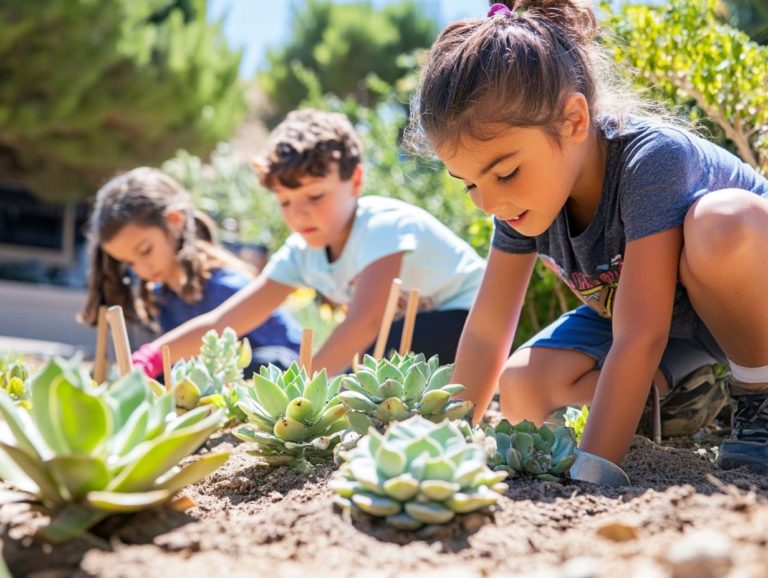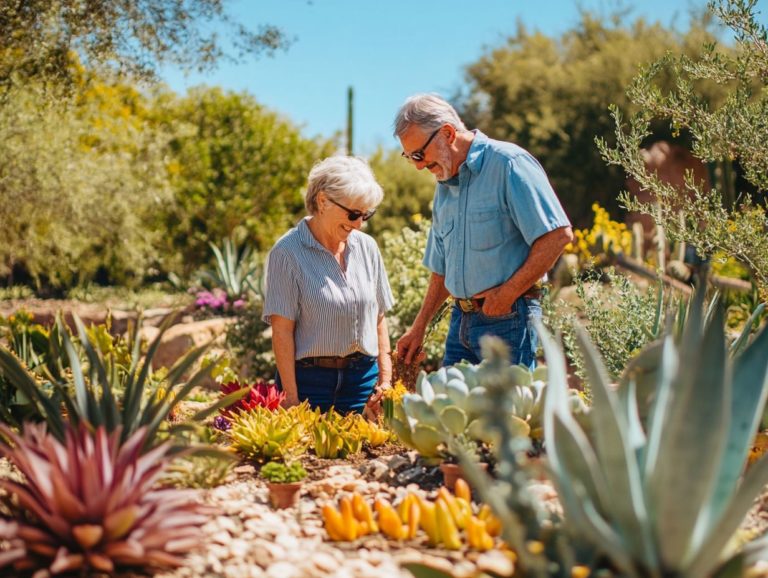How to Get Started with Drought-Resistant Gardening
As climate change escalates and water scarcity becomes increasingly common, embracing drought-resistant gardening is not just necessary; it’s a chance to create a beautiful, sustainable garden!
This article delves into the significance of water conservation. You’ll discover how to choose the right plants that thrive with minimal moisture. Along with practical steps for preparing your garden, you’ll learn innovative irrigation techniques that ensure every precious drop counts.
You ll find maintenance tips and discover alternative gardening methods for drought-prone areas. It s time to adopt a greener, more resilient approach to gardening and transform your outdoor space into a thriving sanctuary.
Contents
- Key Takeaways:
- The Importance of Drought-Resistant Gardening
- Choosing Drought-Resistant Plants
- Preparing Your Garden for Drought
- Watering Techniques for Drought-Resistant Gardening
- Maintenance and Care for Drought-Resistant Gardens
- Alternative Gardening Methods for Drought-Prone Areas
- Frequently Asked Questions
- 1. What is drought-resistant gardening?
- 2. How do I know if drought-resistant gardening is right for me?
- 3. What are some tips for getting started with drought-resistant gardening?
- 4. Do I need to completely change my current garden setup for drought-resistant gardening?
- 5. Are there any benefits to drought-resistant gardening?
- 6. Can I still have a colorful garden with drought-resistant gardening?
Key Takeaways:

- Understand the need for water conservation and the importance of drought-resistant gardening.
- Choose plants that require less water and benefit both your garden and the environment.
- Prepare your garden with effective irrigation techniques and maintenance for a thriving drought-resistant space.
The Importance of Drought-Resistant Gardening
Drought-resistant gardening is crucial as dry conditions worsen. In places like Southern California, water scarcity impacts both city and rural areas.
By opting for drought-tolerant plants, you can create stunning landscapes while significantly reducing water consumption and supporting water conservation.
This eco-conscious approach not only preserves invaluable resources but also nurtures native plants and wildlife, enhancing biodiversity within our ecosystems and promoting water use efficiency.
Recognizing the significance of drought-resistant species is essential for sustainable gardening practices, especially when preparing your garden for drought conditions that thrive even in dry climates.
Understanding the Need for Water Conservation
In California, there is an urgent need for water conservation due to increasingly severe drought conditions and limited water resources driven by population growth.
This situation is exacerbated by factors like climate change and inefficient water management practices, straining the already diminished supply. Urban areas, with their substantial demands for landscaping, and rural regions reliant on agriculture, face serious challenges.
Implementing sustainable practices has never been more critical. We need a shift toward innovative water-saving technologies and community initiatives. You can play a vital role in these efforts by promoting strategies like rainwater harvesting (collecting rainwater for garden use) and xeriscaping (landscaping that reduces or eliminates the need for irrigation).
Neighborhoods can band together to implement initiatives that cultivate a culture of conservation, paving the way for a more resilient future for everyone.
Choosing Drought-Resistant Plants
Selecting the right drought-resistant plants is essential for cultivating a flourishing garden. Before you begin, consider what to consider before starting a drought garden to ensure it thrives in dry conditions while reducing water consumption.
By prioritizing drought-tolerant species, you can craft a landscape that enhances the beauty of your surroundings while conserving water and nurturing local ecosystems.
Opting for native plants like Asclepias tuberosa and Agave parryi proves particularly effective, as these varieties are naturally adapted to your local climate and demand minimal care once established.
Characteristics and Benefits of Drought-Resistant Plants
Drought-resistant plants possess remarkable characteristics and adaptations that enable them to flourish in low-water conditions. They are the perfect choice for your water-wise gardening endeavors.
These species often develop deep root systems that reach underground water sources, allowing them to access moisture that eludes other plants. Their leaves may feature a waxy or hairy texture to minimize water loss through evaporation.
By incorporating these plants into your landscape, you can significantly reduce maintenance demands and lower water consumption. This is an especially savvy choice in arid environments.
Their inherent resilience translates to a reduced vulnerability to pests and diseases, contributing to a healthier ecosystem overall. Managing soil moisture is crucial for maximizing the benefits of drought-resistant flora. Controlling invasive weeds will further ensure that your plants have access to vital resources.
Preparing Your Garden for Drought

Preparing your garden for drought requires meticulous planning. Focus on effective garden design and improving the soil by following guidelines on how to plan a drought-resistant garden layout to create an environment that supports drought-tolerant plants.
By taking these steps, your garden can thrive even in challenging conditions.
Steps to Take Before Planting
Before you plant, it’s crucial to prepare your garden for drought-resistant plants. This involves proper soil improvement and effective planting design.
Start by focusing on soil preparation. It can significantly enhance the growing environment. Test your soil for nutrient deficiencies and amend it with organic matter like compost to boost fertility and improve structure.
Next, consider your watering requirements. Deep watering means soaking the soil deeply so roots can reach water below the surface. This technique builds strong roots, giving plants better access to moisture during dry spells.
When you combine properly prepared soil with smart watering strategies, you create a thriving ecosystem that allows your plants to flourish despite environmental challenges.
Watering Techniques for Drought-Resistant Gardening
Employing efficient watering techniques is essential for achieving success in drought-resistant gardening. To learn more about optimizing your approach, check out how to plan your garden for drought seasons. This ensures that your plants receive just the right amount of water, minimizing waste and maximizing their resilience.
Water-Saving Strategies for Your Garden
Implementing effective water-saving strategies is crucial for maintaining a vibrant garden while adapting to drought conditions. By embracing these practices, you can significantly reduce water consumption and ensure sustainability in your outdoor spaces.
For example, optimize landscape watering through efficient scheduling and use drip irrigation systems to deliver water directly to the roots, minimizing waste. Applying mulch around plants creates a protective barrier that helps retain moisture in the soil.
Grouping plants with similar water needs simplifies your watering efforts for more uniform hydration. Integrating soil moisture sensors into your gardening routine provides real-time data, enabling precise watering and enhancing overall water efficiency.
Maintenance and Care for Drought-Resistant Gardens
Maintaining a drought-resistant garden requires careful attention and specific practices. For guidance, refer to this how to plan a drought-resistant community garden to ensure your plants flourish despite limited water availability.
By adopting the right techniques and strategies, you can create an environment where your garden not only survives but thrives, showcasing resilience and beauty in challenging conditions.
Get started today to ensure your garden thrives during dry spells!
Tips for Keeping Your Garden Healthy and Thriving

To maintain a healthy and thriving drought-resistant garden, regularly assess the health of your plants and adjust your care practices accordingly.
Monitoring for pests is an important part of ensuring your garden thrives. By keeping a close eye on your plants, you can catch any infestations early and prevent potential damage that might jeopardize their growth.
Adopting optimal watering practices like deep, infrequent watering sessions encourages robust root systems for drought-tolerant species. This allows your plants to better withstand drought conditions.
Seasonal adjustments, like applying mulch during the hotter months, help conserve moisture and regulate soil temperature, creating a more stable environment for your plants.
Understanding how drought conditions impact your plants’ overall well-being is crucial. This insight lays the foundation for ways to manage your garden based on its needs, significantly boosting resilience and longevity, particularly in drought-prone areas.
Alternative Gardening Methods for Drought-Prone Areas
Exploring alternative gardening methods is essential for successfully cultivating plants in drought-prone areas. By focusing on environmentally friendly solutions and sustainable practices, you can create a thriving garden that withstands limited water challenges and contributes positively to the ecosystem.
Exploring Different Gardening Techniques
Exploring various gardening techniques uncovers effective water-wise choices, including plants that need little water, leading to flourishing gardens, especially in drought-prone regions.
By adopting strategies like raised beds, you can enhance drainage and ensure better access to sunlight. Container gardening offers remarkable flexibility, enabling you to create customized soil mixes that effectively retain moisture an undeniable advantage in arid climates.
Incorporating organic materials, such as compost and mulch, enriches the soil and boosts its water retention capacity. This creates an ideal environment for your plants to thrive.
Take time to evaluate local weather patterns! Choosing the right technique can transform your garden’s success.
Frequently Asked Questions
1. What is drought-resistant gardening?
Drought-resistant gardening focuses on conserving water and adapting to dry conditions. It involves choosing plants that thrive in drier climates and implementing techniques to reduce water usage. For more information, check out what are the essentials for starting a drought garden.
2. How do I know if drought-resistant gardening is right for me?

If you live in an area prone to drought or want to conserve water in your garden, then drought-resistant gardening is definitely worth considering. It can also be a great option for those who want a low-maintenance garden.
3. What are some tips for getting started with drought-resistant gardening?
First, assess your garden’s current water usage and make a plan to reduce it. Choose native plants known to be drought-resistant and implement techniques such as mulching and drip irrigation. For a detailed approach, check out this guide on how to plan a drought-resistant garden layout to help conserve water.
4. Do I need to completely change my current garden setup for drought-resistant gardening?
Not necessarily. You may need to make some adjustments, like switching out some plants for drought-resistant ones. However, you can still incorporate elements of your current garden into a drought-resistant design.
5. Are there any benefits to drought-resistant gardening?
Yes, there are many benefits! Aside from conserving water, drought-resistant gardening can save you time and money on maintenance, attract pollinators to your garden, and create a unique and beautiful landscape.
6. Can I still have a colorful garden with drought-resistant gardening?
Yes, you can! Many drought-resistant plants produce vibrant colors and beautiful blooms.
Plus, you can add colorful elements like painted pots and outdoor decor. These touches will bring lively pops of color to your garden.






